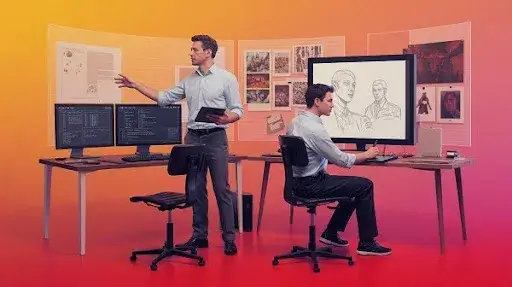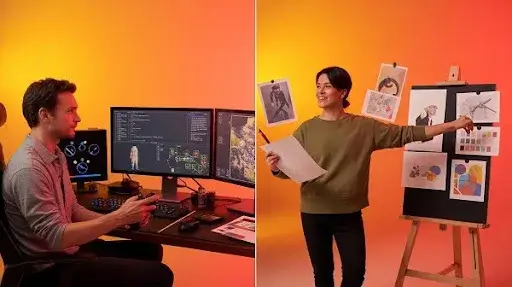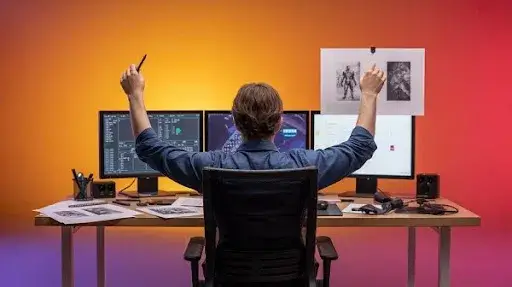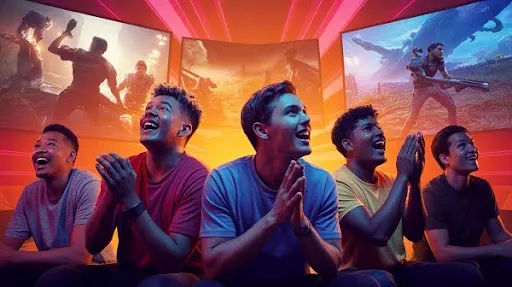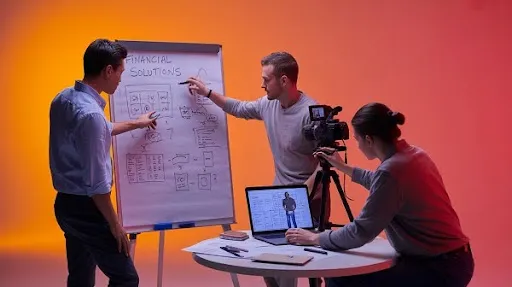A game doesn’t become memorable just because it looks good or plays well. The real spark comes from the pairing of two leadership minds steering everything behind the scenes: the game director and the creative director. These are two different seats at the same table, and yet people still mix up what each person actually does.
Some think the creative director just handles “art stuff,” while others assume the game director only deals with production logistics. That confusion is exactly why a lot of teams end up with mismatched expectations, wasted revisions, and projects that feel stitched together instead of built with intent.
Studios that understand the difference between game director and creative director roles avoid those headaches. They build stronger communication, cut roundabout decision-making, and stop creative chaos from spiraling into lost time and budget nightmares.
And for anyone trying to grow in the video game industry, from artists to designers to producers, understanding how these leadership positions function is non-negotiable.
This breakdown isn’t fluff; it’s meant to clarify the line between vision and execution without losing the creative spark that drives games in the first place.
What is a Game Director?
A game director is the one responsible for making sure a game doesn’t collapse under its own ambition. They don’t just approve things; they steer the full operation. The vision, the budget, the priorities, the pace, the risk management, and the communication between every department tie back to this person.
One data source indicates that there were approximately 4,838 gaming director positions in the United States, with an expected job increase of 17% from 2018 to 2028.
Roles of Game Director
A game director oversees the direction of the project as a whole. That includes the tone, mechanics, milestones, production pipeline, and team synchronization. Their work is less about individual tasks and more about keeping the machine aligned.
They answer questions like:
- Is this feature doable in time?
- Does this decision break the scope?
- Are teams working toward the same goal?
- What gets cut when time starts running out?
The title might sound purely managerial, but this role holds more weight than a project manager or senior producer. They have the final word on what stays, what shifts, and what stops.
Game Director Responsibilities
Some of the core responsibilities fall into these buckets:
- Final Decision-Making
They approve or decline features, direction changes, scope increases, and compromises. When feedback comes from CEOs, clients, or publishers, they’re the filter.
- Team Movement and Clarity
The game director keeps departments from drifting apart. They prevent artists from working off one assumption while design runs in another direction.
- Resource Balancing
Budgets and deadlines aren’t abstract to them. They weigh impact against cost. If the creative director wants a massive new cinematic sequence, they’re the one who checks if that means pushing back launch by two months.
- Accountability
If the game fails or a delay happens, the game director is the one who shoulders the blame publicly and internally. It’s a leadership role with pressure that doesn’t show on credit lists.
Skills for Game Director
The skills needed to fill that seat go beyond being “good at managing.” A strong game director normally has:
- Problem-solving under pressure
- Broad production knowledge (engineering, design, art, QA)
- Budget and timeline awareness
- Strong communication
- The ability to say no at the right time
- Leadership that isn’t loud but firm
This is not a position people fall into by luck. It usually comes from working through roles like lead designer, lead producer, gameplay director, technical lead, or narrative lead over several projects.
How to Become a Game Director
There’s no shortcut. People who become game directors tend to build up a track record of solving problems across departments, not just within one. They understand pipelines, know how to work with creative personalities, and don’t get rattled when things break in development.
Hands-on production experience matters more than certificates. Someone who has shipped multiple games and learned how decisions affect every role in game production has a stronger shot than someone with a title but no delivery record.
That’s why game development leadership roles always require real development history. Teams won’t follow a game director who hasn’t been in the trenches.
What Does a Creative Director Do in Gaming?
The creative director shapes the emotional identity of the game. They don’t manage the entire pipeline; they define what the game should feel like, look like, and express. If the game director keeps the machine running, the creative director makes sure the machine builds something worth playing.
Roles of Creative Director
The creative director establishes the vision behind elements like story direction, tone, visual style, character identity, and thematic consistency. They’re not just an art lead. Their choices influence writing, cinematics, environment design, animation, sound, and even UI.
They set the direction so every creative decision points toward the same experience. No clashing tones. No disconnected emotions. No story beats that feel like they belong to another project.
Creative Director Responsibilities
The responsibilities stretch across multiple creative disciplines:
- Narrative Direction
They guide story shaping, character arcs, voice tone, and the emotional pull behind the plot.
- Visual Identity
They align with concept artists, art directors, animators, and UI teams to reinforce a style that supports the game’s message.
- Emotional Consistency
They assess not just if something looks right, but if it feels connected to the experience.
- Feedback and Refinement
They don’t do every job, but they provide notes that shape the creative choices across departments.
- Collaboration with the Game Director
They raise red flags when core emotional beats get lost or compromised because of production limitations.
Skills for Creative Director
To stay effective, a creative director needs:
- A strong aesthetic sense
- Storytelling instincts
- A collaborative approach instead of dictating from above
- Cross-team communication
- The ability to protect creative vision without being rigid
- Empathy for both the audience and the dev team
Someone in this role can’t afford to be hands-off or disconnected. They earn trust by helping people create something with depth, not by micromanaging details.
How to Become a Creative Director in Games
Almost every creative director in gaming started off in a hands-on role, concept art, level design, writing, character design, cinematic design, UI art, animation direction, or content direction.
What gets people into creative direction isn’t just talent. It’s the ability to create cohesion across departments and keep a single tone alive as things change during production. A strong portfolio helps, but leadership through collaboration and vision is what moves someone up the ladder.
Game Director vs Creative Director: The Core Difference
A lot of people boil this down to “one handles production, one handles art”, but that’s not the full picture. The difference between game director and creative director comes down to control over execution versus ownership of creative expression.
Here’s the simplest division:
- The game director asks: “Will this work across the full pipeline?”
- The creative director asks: “Does this feel like the game we’re making?”
Neither outranks the other by default; the hierarchy depends on the studio and project structure. In AAA studios, the game director often has final authority, but the creative director holds serious influence over the heart of the experience.
A game director thinks about timelines, resource stress, technical restraints, player experience, and production risk. A creative director thinks about story direction, style cohesion, character purpose, and the game’s mood and meaning.
They cross paths constantly in areas like:
- Feature approval
- Scope adjustments
- Tone protection
- Story mechanic alignment
- Voice acting direction
- Cutscene planning
- Art pipeline compromise
- Player experience feedback
If either one stops communicating, the game cracks down the middle. You get stunning visuals with empty impact, or rock-solid mechanics coated in bland identity.
Game Art Services and Their Place in This Structure
When studios outsource elements like game art services, both director roles get involved, but for different reasons.
The game director approves outsourcing plans based on scope, deadlines, budget, and pipeline compatibility. They’re making sure assets won’t slow down the production pipeline or break the schedule.
The creative director oversees quality and alignment. They look at whether a character model actually fits the tone, if backgrounds match the setting, and if the art direction stays consistent across external teams.
Outsourcing without both directors in sync leads to mismatched results, art that looks technically polished but emotionally off, or revisions that eat up production time.
Prolific Studio and other service providers usually prefer working with creative leads early. That minimizes rework, gives clarity on expectations, and allows the game director to keep the wheels turning without fire drills.
Leadership in Game Development
Games with confused creative direction or badly managed production don’t fail because the concept was bad. They fail because leadership roles weren’t clear. When a team doesn’t know who owns creative decisions vs production decisions, things get muddy fast.
Miscommunication shows up in:
- Conflicting feedback from leads
- Delays caused by unclear approvals
- Features getting reworked multiple times
- Budgets drained by misaligned priorities
- Tone shifts that confuse players
- Half-built mechanics that clash with story intent
A solid game studio team structure has both roles clearly defined from day one. A video game director handles feasibility and delivery. A creative director in gaming owns the emotional, visual, and narrative identity. They both shape the foundation, but through different lenses.
The reason studios like Naughty Dog, Santa Monica Studio, and CD Projekt RED produce recognizable, impactful games isn’t accidental. It comes from having leadership that respects the line between logistics and creative voice.
When One Person Wears Both Hats
Not every studio splits the roles. In some smaller teams, one person is both the game director and creative director. That setup can work when the scope is tight and the team is small, but it only functions when that person has instincts for both structure and vision.
The risk shows up when production stress crushes creative direction, or creativity spirals beyond time limits. Balancing both mindsets is rare but not impossible. Some directors lean more toward execution and pull in senior artists or writers to anchor the emotional tone.
Cory Barlog on God of War is an example often brought up. Even though he held the title of creative director, he also managed production choices like a game director. But that success didn’t happen alone; teams still surrounded him to support both fronts.
The impact of having both roles combined depends on budget size, studio culture, and the scope of the project.
Why The Gaming Creative Process Needs Two Directors
Creative direction in games is fragile. It gets chipped away by production changes, bugs, rewrites, pacing issues, and art revisions. Without someone protecting the tone and soul of the game, you’re left with a playable product that nobody remembers.
On the flip side, passion without structure leads to delays, scope creep, and rewrites that shouldn’t have happened. You end up with a “vision” that never becomes a finished title.
The partnership between these roles is not ceremonial; it’s practical. One owns the heart. One owns the spine. And when those two parts sync, teams don’t drown in revisions and direction changes.
Frequently Asked Questions
What does a game director do day-to-day?
They handle decision approvals, scope control, team coordination, production health checks, and communication between departments. Their job is making sure the project stays buildable.
What does a creative director do in gaming?
They guide tone, storytelling, artistic identity, emotional direction, and cohesion across writing, visuals, audio, and cinematics.
Can one person be both game director and creative director?
Yes, but it’s rare and risky on larger projects. It only works when that person understands both structure and vision without dropping one for the other.
What skills do you need to become a game director?
Strong communication, production insight, decision-making under pressure, technical understanding, and experience across multiple development cycles.
What skills matter most for a creative director in games?
Story sense, aesthetic awareness, collaborative leadership, emotional clarity, and the ability to guide without micromanaging.
Where do game art services come into this?
Outsourcing requires both directors. The game director checks feasibility and timeline impact. The creative director checks consistency and visual alignment.
How is a creative director different from an art director in games?
An art director owns visual execution. A creative director owns overall emotional direction, tone, and thematic cohesion across multiple departments.
Who has more control in game development?
Authority depends on studio structure, but both roles influence different pillars. Production can’t function without the game director. Identity falls apart without the creative director.
Final Words
Studios that respect the line between execution and creative identity avoid the mess that slows most projects down. A game director keeps the project alive. A creative director makes sure it’s worth building. One protects feasibility. One protects meaning. When a studio tries to run without both voices or treats them like interchangeable roles, teams burn time, redo work, and lose direction.
Prolific Studio works with both sides of that structure. Projects land smoother when production strategy and creative control don’t fight for space. If your team needs support across concept art, storytelling, asset production, or visual direction, bringing in the right creative guidance early prevents rewrites and wasted revisions later.
And if what you’re missing is direction at the production level, aligning with a team that understands scheduling and delivery keeps things from derailing.
Games don’t fail because people lack passion. They fail because no one defined who leads the heart and who leads the build. When those roles are clear, development doesn’t just run; it finishes strong.
Related Articles:

